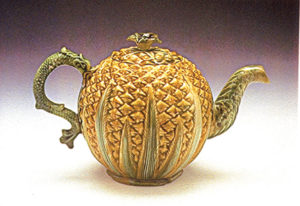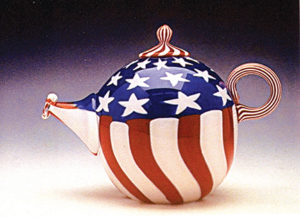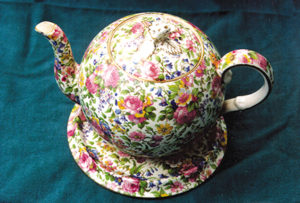 By Robert Reed
By Robert Reed The teapot in all of its remarkable forms has been courted by civilization for centuries. It is a romance that prompted one prestigious American museum to call the teapot “the most perfect of inventions.”
A love story which may have begun with the Chinese 500 years ago certainly has endured in countless countries and cultures. The forms have been vastly diverse, and the materials incorporated in individual designs has been equally wide ranging.
“One of great challenges for an artist was to make a great teapot,” observed Garth Clark guest curator of The Mint Museums in Charlotte, North Carolina. “It was a matter of proportion, balance and function. Artists had to be able to produce a main body balanced against two linear elements, the spout and handle.”
Garth added, “it sounds easy, but it was actually quite a difficult thing to do, even more so if you’re going to do something distinctive and unique.”
The Mint Museums chose to devote the first half of the year 2004 to an exhibition of more than 250 teapots along with archival drawings and related documents. Major artists of the past were represented as well as the anonymous folk potter.
 Throughout the ages the teapot would be fashioned from all manner of materials from simple earthenware to gleaming silver. Additionally there was glass, iron, and porcelain. Historians credit the Chinese Yixing era with the first development of the teapot. Ultimately the squat form of Chinese hot water pot of porcelain was copied in the Western world but not before tea itself was ‘discovered’ as a precious import from the Orient.
Throughout the ages the teapot would be fashioned from all manner of materials from simple earthenware to gleaming silver. Additionally there was glass, iron, and porcelain. Historians credit the Chinese Yixing era with the first development of the teapot. Ultimately the squat form of Chinese hot water pot of porcelain was copied in the Western world but not before tea itself was ‘discovered’ as a precious import from the Orient. In 1658 a London coffee house advertised a new offering of a drink that would eventually be known as tea. It was “that excellent, and by all Physicians approved of drink, called Chinese Tcha by others Tay alias Tee, is sold at the Sultaness Head.” Just two years later the Samuel Pepys wrote in his diary, “I did send for a cup of tea, a China drink, of which I never drank before.”
Not surprisingly the tea drinking fad had grown strong enough in the 1670s for a few teapots to actually be produced. One example was actually inscribed “tea pott” for those who may have been puzzled by its appearance. Still another lantern-shaped teapot of silver of the same period bore the hallmark of the East India Company which had a major role in the importation of tea itself from China.
Both tea and coffee drinking became quite fashionable in London and other parts of England by the early 1700s. At that point both were similar in design and relatively small given that both commodities were scarce and expensive. As tea became more readily available the standard size of accompanying tea pots increased. For the most part the early lantern-shape evolved into a bulb-like in form with a high-domed lid. Some had what were later called “duck neck” spouts.
It was not surprising that the endearing teapot made its way to Colonial America. In 1727 the New York Gazette advertised an elegant silver “Eight square Tea-Pot” which was said to be of the “newest Fashion.” For a time the ‘eight square’ or octagonal form of teapot was very popular with silversmiths. The well to do both in England and America sat an impressive table with their distinguished silver teapots with C-scrolled handles and S-style spouts.
 The curved handle was apparently considered more suitable than the lesser used square handle. Gradually too, the rather basic pear shape became the most favored design for 18th century teapots, especially for those imported to America. It has been said that the pear shape was preferred in part because that particular design helped the tea steep better by putting the maximum amount of water in direct contact with the leaves. While silver was reportedly very well suited for the brewing of tea, it certainly was not the only material used for teapots in Colonial America. In fact the majority of teapots crafted in that era were likely of earthenware. They were, according to Marvin Schwartz author of the Collector’s Guide to Antique American Ceramics, “simple, turned on a wheel, and easily made.” Most of such earthenware teapots of the latter 18th century were described as “squat” and glazed in various shades of brown.
The curved handle was apparently considered more suitable than the lesser used square handle. Gradually too, the rather basic pear shape became the most favored design for 18th century teapots, especially for those imported to America. It has been said that the pear shape was preferred in part because that particular design helped the tea steep better by putting the maximum amount of water in direct contact with the leaves. While silver was reportedly very well suited for the brewing of tea, it certainly was not the only material used for teapots in Colonial America. In fact the majority of teapots crafted in that era were likely of earthenware. They were, according to Marvin Schwartz author of the Collector’s Guide to Antique American Ceramics, “simple, turned on a wheel, and easily made.” Most of such earthenware teapots of the latter 18th century were described as “squat” and glazed in various shades of brown. Early in 19th century America the pear shape teapot was still the uppermost choice. For those who could not fully afford a fine silver teapot, then pewter was the next best thing. The New England area was particularly flush with works of pewter during the first few decades of the 1800s. Connecticut pewter craftsmen Thomas and Sherman Boardman were said to have sold some three thousand teapots to eager customers during a six month period in the 1820s.
A tea tip for readers of the American Frugal Housewife in 1833 suggested that homemakers be sure the water boils before pouring upon the tea. It added, “a teaspoonful to each, and one extra thrown in, is a good rule.”
Quality earthenware teapots, not just ‘simple’ ones, were being made in the United States by the 1850s. Exceptional examples included black-glazed creations by John Mann of Rahway, New Jersey and green and gold glazed offerings by E. W. Bennett of Baltimore, Maryland. Bennett’s Rebekah at the Well design remained a standard for the next several decades.
The color of tea took on greater importance too by the middle of the 19th century. “Black tea is healthier than green,” suggested on published reference at the time, “half and half, is a pleasanter beverage than either alone, and safer for those who drink strong tea, than to trust themselves wholly with green.” In 1857 Beecher’s Recipe Book offered directions for making white tea, “put two teaspoonfuls of sugar into a half cup of good milk, and fill it with boiling water.”
By the latter 1860s the consummate teapot might well have been part of a three piece set produced in New York City by Tiffany and Company. The teapot was a cherished combination of sterling silver, ivory, and silver gilt. No doubt the retail price was as breath-taking as its visual image.
For the more down-to-earth tea consumer in the Untied States there were glazed majolica pottery designs abundant in the 1880s. One of the most noted potteries of that decade was operated by Griffin, Hall and Smith at Phoenixville, Pennsylvania. Some of their cauliflower-shaped teapot designs were said to have been inspired by earlier models in 18th century England.
Early in the 20th century just about everyone in the country could (and probably did) purchase a teapot at a reasonable price. In 1908 the Sears and Roebuck company offered True Blue enameled one-quart teapots for 37 cents each. A four-quarter tea kettle of the same enameled ware was 76 cents.
Elsewhere a Dutch designed brass teapot had been impressive when displayed at the first Arts and Crafts Exhibition held in Italy. Back in the United States, around 1911, there were exceptional teapots made by Shreve and Company. Based in San Francisco, California their sterling silver and ivory designs were extraordinary.
In Europe during the 1920s the expanse of fine teapots extended from the lovely translucent china Shelley tea ware in England to the sleek and modernistic work of Jean Puiforcat in France. By the early 1930 Puiforcat had even incorporated plastic into his teapot works of silver and silver gilt.
During the 1930s Japanese produced teapots were often influence by the mood of Art Deco and reflected geometric styling in bright shades of green and other colors. By contrast Royal Winton delighted customers in Old English fashion with their striking chintzware decorated in traditional floral patterns.
Later Royal Doulton continued the English legend with the rustic garden look of Old Country Roses which became a worldwide best-seller as late as the 1960s.
Clearly in design and function the teapot has gone around the world and back again over the ages. Its image still serves to make the heart grow fonder yet today.















Follow Us